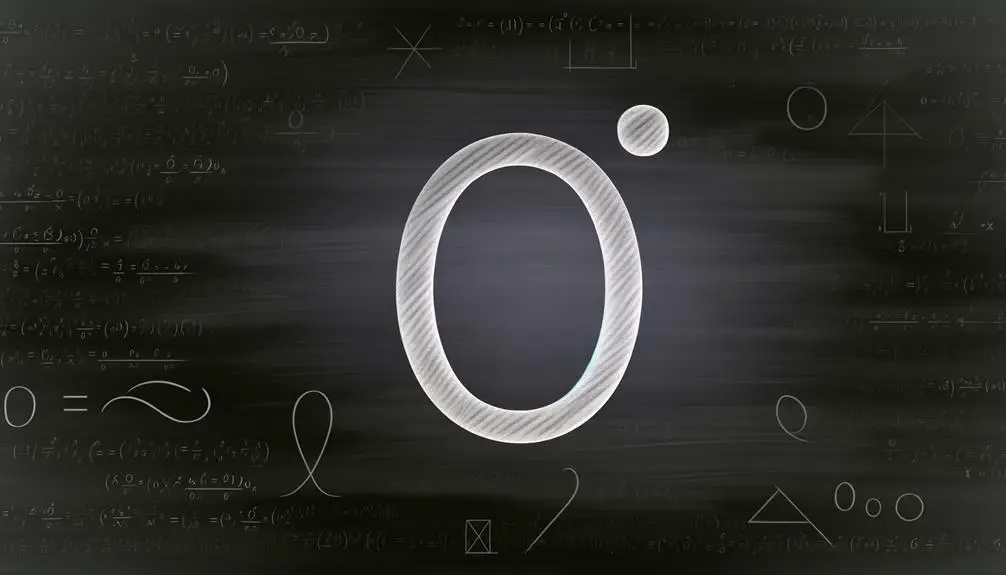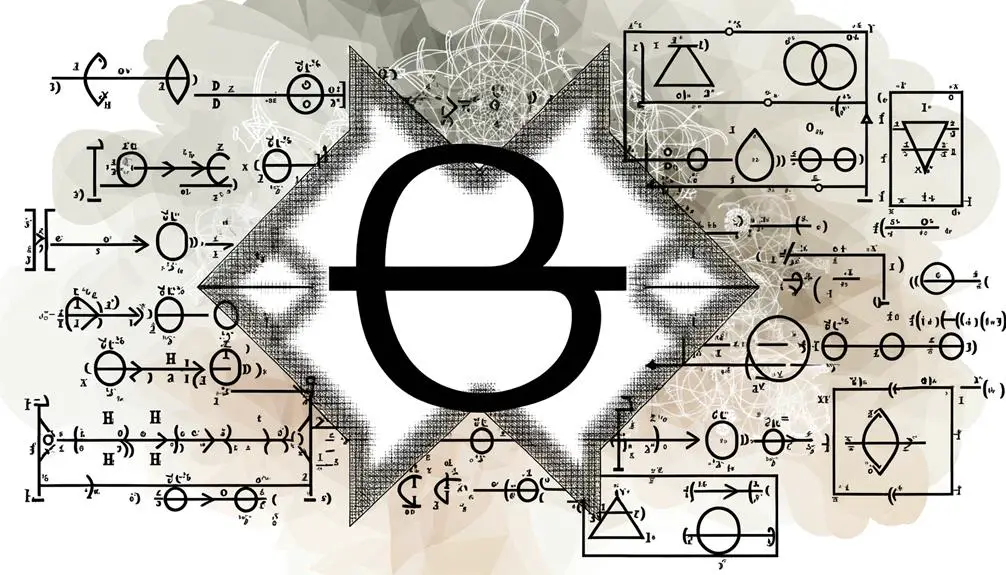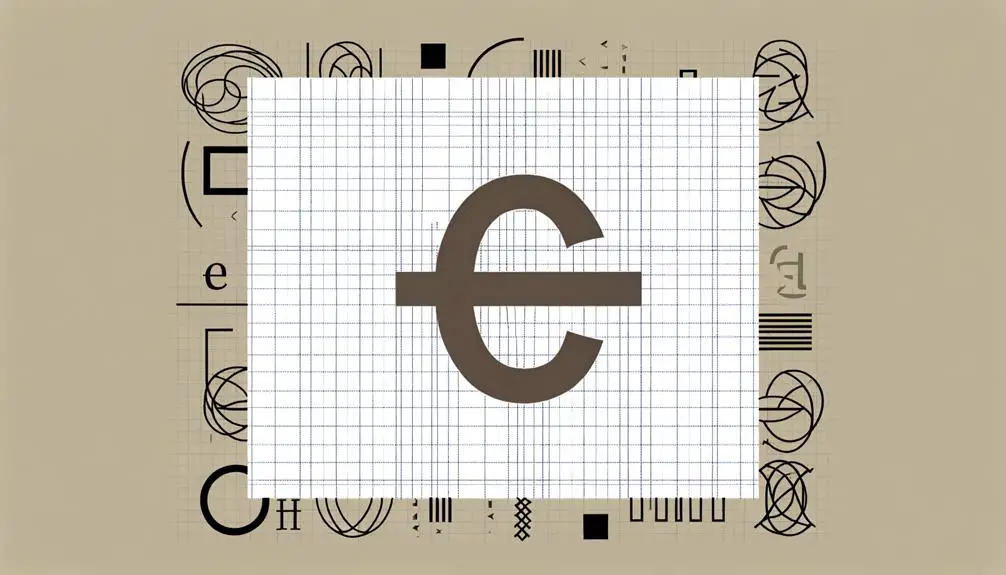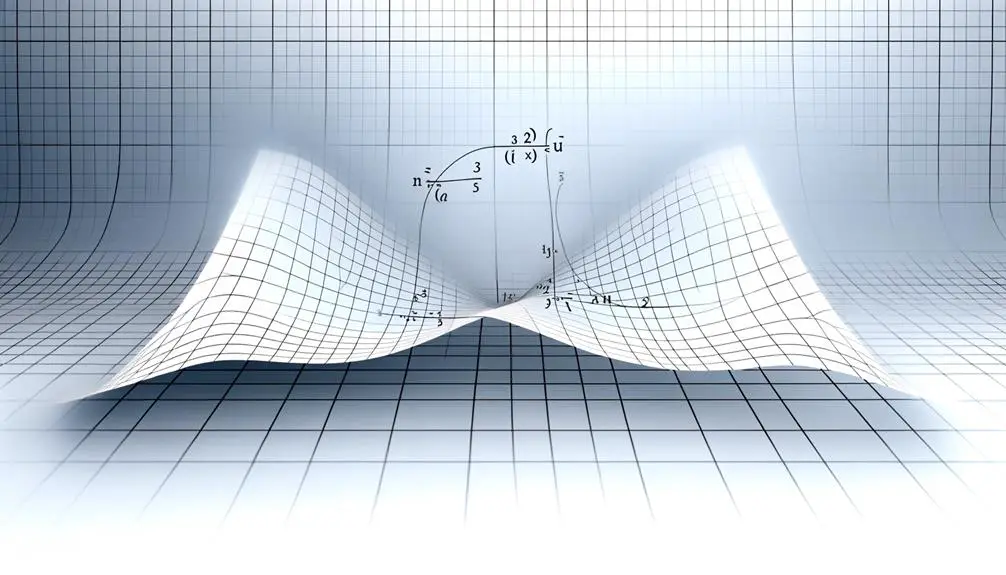What Does the Tilde Symbol Mean in Math?
The tilde symbol (~) in mathematics serves multiple purposes. It denotes approximate equality, streamlining complex calculations.
In geometry, it signifies similarity between shapes, particularly triangles with congruent angles and proportional side lengths. It also represents proportional relationships, indicating a constant ratio between variables.
In logic, it denotes negation, such as inverting truth values, while in advanced mathematics, it describes asymptotic behavior and homotopy equivalence. The symbol is essential for conveying nuanced mathematical concepts.
To explore the full range of applications and depth of the tilde symbol's usage in various fields, further examination is essential.

Key Takeaways
- The tilde (~) denotes approximate equality, simplifying complex calculations and conveying numerical estimations.
- In geometry, the tilde (~) signifies similarity, especially in identifying similar triangles with congruent angles and proportional sides.
- The tilde (~) represents proportional relationships, indicating a constant ratio between variables in various scientific fields.
- In logic, the tilde (~) denotes negation, inverting the truth value of propositions for formal reasoning and proofs.
- The tilde (~) describes asymptotic behavior, showing the similarity of functions as input values grow large.
Approximation Indicator

In mathematical notation, the tilde symbol (~) is frequently employed to indicate that two quantities are approximately equal. This usage is particularly prevalent in numerical analysis, where exact values are often impractical or impossible to obtain.
For instance, one might write π ~ 3.14 to express that the value of π is approximately 3.14. This symbol serves as a critical tool for simplifying complex calculations and conveying estimations without the need for excessive decimal precision.
It is essential to recognize that the tilde does not imply exact equality but rather a close proximity in value, thereby facilitating clearer communication in mathematical discourse. This approximation indicator is indispensable for conveying mathematical concepts succinctly while acknowledging inherent limitations in precision.
Similarity in Geometry
In geometry, the tilde symbol (~) is commonly used to denote similarity between shapes, particularly triangles. Identifying similar triangles involves verifying that corresponding angles are congruent and the ratios of corresponding side lengths are proportional.
This proportionality forms the basis for many geometric proofs and applications, underscoring the fundamental role of similarity in mathematical analysis.
Identifying Similar Triangles
Understanding the principles of identifying similar triangles is vital for solving a wide range of geometric problems. Similar triangles are defined by having corresponding angles that are equal and corresponding sides that are proportional. This identification is important in various geometric applications, from basic problem-solving to advanced theorem proofs.
To identify similar triangles, one must:
- Verify that corresponding angles are congruent.
- Confirm that corresponding sides are proportional.
- Utilize the Angle-Angle (AA) similarity postulate.
- Apply the Side-Angle-Side (SAS) and Side-Side-Side (SSS) similarity theorems.
These criteria secure a rigorous approach to determining similarity, providing a foundation for further geometric analysis. Mastery of these principles enables efficient and accurate solutions in the field of geometry.
Proportional Relationships Explained
Building upon the identification of similar triangles, a deeper understanding of proportional relationships becomes essential in elucidating the principles of similarity in geometry.
When two triangles are confirmed to be similar, their corresponding sides maintain a consistent ratio, known as the scale factor. This proportionality implies that the lengths of corresponding sides are multiples of a common factor, while corresponding angles remain congruent.
The concept of proportional relationships extends beyond triangles to other geometric figures, reinforcing the foundational idea that similarity is characterized by consistent scaling.
Mastery of these relationships is vital for solving problems involving indirect measurements, transformations, and real-world applications in fields such as architecture, engineering, and physics.
Consequently, proportional relationships are indispensable in the study of geometric similarity.
Equivalence Relations

Equivalence relations are a fundamental concept in mathematics that describe a specific type of relationship between elements of a set, ensuring they are comparable in a manner that satisfies reflexivity, symmetry, and transitivity.
An equivalence relation partitions a set into disjoint subsets where every element is related to every other element within the same subset. This is essential for structuring and organizing data in a meaningful way.
Consider the following properties:
- Reflexivity: Every element is related to itself.
- Symmetry: If an element \(a\) is related to an element \(b\), then \(b\) is also related to \(a\).
- Transitivity: If \(a\) is related to \(b\) and \(b\) is related to \(c\), then \(a\) is related to \(c\).
- Partitioning: The set is divided into equivalence classes where each element belongs to one class.
Proportionality Sign
The proportionality sign, often represented by the tilde symbol (~), signifies that two quantities are proportional to each other, implying a constant ratio between them. In mathematical terms, if \( a \) is proportional to \( b \), this relationship can be denoted as \( a \sim b \). This indicates that there exists a constant \( k \) such that \( a = kb \).
Proportional relationships are foundational in various fields, including physics, economics, and engineering, where they describe how one variable changes in relation to another. Understanding this concept is essential for analyzing data, formulating equations, and solving problems that involve direct or inverse proportionality.
The proportionality sign thereby succinctly encapsulates fundamental interdependencies between variables.
Negation in Logic

In logic, the tilde symbol (~) is commonly employed to denote negation, fundamentally altering the truth value of a given proposition.
Truth tables serve as essential tools in this situation, systematically illustrating the effects of negation on logical statements.
Practical applications of this symbol are widespread, extending from mathematical proofs to computer science algorithms, underscoring its significance in formal reasoning.
Symbol Representation
Representing negation in logic, the tilde symbol (~) functions to denote the logical operation that inverts the truth value of a given proposition. This symbol is integral in formal logic and is often utilized in constructing logical expressions.
When applied to a proposition, it transforms true into false and vice versa, thereby serving as a fundamental operator in logical calculus. The representation of negation using the tilde symbol is characterized by several key aspects:
- Symbolic Notation: `~P` indicates the negation of proposition `P`.
- Truth Value Inversion: If `P` is true, `~P` is false; if `P` is false, `~P` is true.
- Logical Consistency: Maintains the integrity of logical operations.
- Widespread Usage: Commonly found in mathematical logic, computer science, and philosophy.
Truth Tables Usage
Understanding the application of the tilde symbol in logical operations necessitates an examination of how truth tables are used to illustrate negation in logic. Negation, represented by the tilde (~), inverts the truth value of a given proposition. The truth table for negation provides a clear and systematic way to visualize this operation. Below is a truth table that demonstrates the effect of negation:
| Proposition (P) | Negation (~P) |
|---|---|
| True | False |
| False | True |
This table succinctly shows that if the original proposition (P) is true, its negation (~P) will be false, and vice versa. Such tables are fundamental in logical reasoning, enabling one to rigorously analyze and understand the implications of negation in various logical contexts.
Practical Applications
Negation in logic is employed across various fields, including computer science, mathematics, and philosophy, to reverse the truth value of propositions, thereby facilitating complex problem-solving and analytical reasoning. The tilde symbol (~) is instrumental in expressing logical negation, offering a means to construct and evaluate the veracity of statements within formal systems.
Practical applications of negation are manifold:
- Computer Programming: Negation is used in conditional statements and loops to control the flow of execution.
- Mathematical Proofs: Logical negation helps in constructing contrapositives and proving statements by contradiction.
- Philosophical Analysis: Negation aids in examining the boundaries of propositions and their implications.
- Circuit Design: In digital logic, negation functions such as NOT gates are fundamental components.
Inverse and Complement
In mathematical notation, the tilde symbol (~) often signifies the inverse or complement of a given set or operation.
In the context of sets, the complement of a set A is denoted as ~A, representing all elements not in A within a universal set.
When used in functions, the tilde can indicate an inverse operation, such as in ~f(x), implying an operation that reverses the effect of f(x).
This usage is vital in fields like algebra and calculus, where understanding inverse functions and sets is fundamental.
The precise application of the tilde symbol enables mathematicians to convey complex ideas succinctly, thereby facilitating accurate communication of mathematical concepts and operations.
Asymptotic Behavior

The tilde symbol (~) is frequently employed in mathematics to describe the asymptotic behavior of functions, indicating that two functions become increasingly similar as their input grows large. This notation is vital in fields such as number theory, calculus, and algorithm analysis, where understanding the long-term behavior of functions is essential.
When analyzing asymptotic behavior, the tilde symbol offers concise, informative insights into the comparative growth rates of functions.
- Comparative Growth Rates: \( f(x) \sim g(x) \) implies \( \lim_{x o \infty} rac{f(x)}{g(x)} = 1 \).
- Algorithm Efficiency: Helps compare the efficiency of algorithms as input size increases.
- Series Expansion: Used in approximations and expansions of functions.
- Simplification: Facilitates the simplification of complex expressions.
Homotopy in Topology
Shifting from the asymptotic analysis of functions, homotopy in topology examines the continuous deformation of one function or shape into another, revealing the fundamental properties of topological spaces. Homotopy is a central concept in algebraic topology, allowing mathematicians to classify spaces based on their intrinsic structural characteristics, rather than geometric specifics. The tilde symbol (~) represents homotopy equivalence, indicating that two spaces can be transformed into each other through continuous mappings. This notion is essential for understanding the invariant properties of spaces under deformation.
| Term | Definition |
|---|---|
| Homotopy | Continuous transformation between functions |
| Homotopy Equivalence | Relation denoted by tilde (~) |
| Topological Space | Set with a structure defining continuous deformations |
| Continuous Mapping | Function preserving the nearness of points |
Homotopy therefore provides deep insights into the qualitative aspects of topological structures.
Tilde in Computer Science

Frequently employed in various programming languages and systems, the tilde (~) serves multiple critical functions in computer science. This versatile symbol is integral in diverse contexts, enhancing both the efficiency and readability of code.
It is frequently utilized in file path representations, logic operations, and within syntax for specific programming languages. Used as a shorthand for the home directory in Unix-based systems, e.g., `~/documents`, it functions as a bitwise NOT operator in languages like C, toggling each bit in a binary representation.
The tilde is also employed in regular expressions to denote pattern matching or negation, and appears in URL encoding to represent special characters, improving web resource accessibility. Each of these applications underscores the tilde's essential role in contemporary computing environments.
Conclusion
The tilde symbol is a versatile emblem in mathematics. It signifies various concepts such as approximation, similarity, equivalence, proportionality, negation, and asymptotic behavior. It also finds applications in logic and topology, enhancing the mathematical lexicon.
Like a chameleon adapting to its surroundings, the tilde's meaning shifts contextually, embodying the dynamic nature of mathematical language. This multifaceted symbol underscores the complexity and interconnectedness inherent in mathematical theory and practice.






